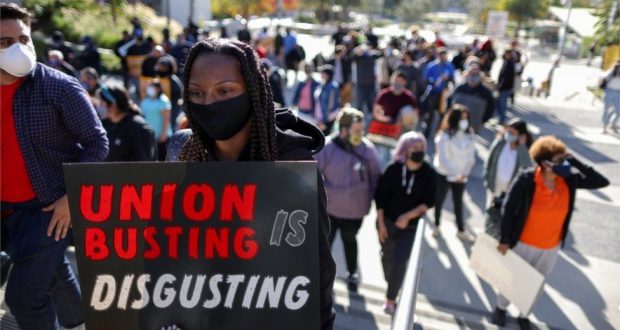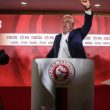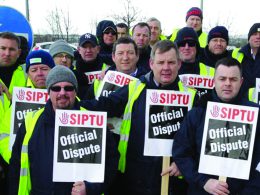By Matt Smith, Socialist Alternative (our sister organisation in the United States)
The most important unionization campaign in recent memory is sweeping the country. Workers at more than 65 Starbucks stores in at least 20 states have formed rank-and-file organizing committees and filed for union elections. Two stores in Buffalo, NY have already won recognition for their union, Starbucks Workers United. From Texas to Missouri to Washington, workers at dozens of stores are fighting to join them.
If Starbucks workers succeed, it will be the most significant private-sector organizing victory for labor since auto giants like Ford and General Motors were unionized in the 1930s and 1940s. A victory at Starbucks would give confidence to workers at other megacorporations like Amazon and McDonalds who want to fight back against their own exploitative bosses.
Will Starbucks bargain “In Good Faith”?
Starbucks has now begun contract negotiations with unionized workers in Buffalo. The company claims it will approach these negotiations “in good faith” but in the same breath, it continues to escalate its national campaign against the union. Just this week, the company fired seven workers at a Memphis store in clear retaliation for their union support.
Starbucks will not bargain in good faith; instead, it will fight tooth-and-nail to destroy the union. Nothing demonstrates this more clearly than the company’s extensive record of union-busting and bad faith negotiation with workers over the last 40 years. To beat Starbucks, we need to know what we’re up against.
Starbucks: Busting unions since 1987
The new boss in Seattle
When former CEO Howard Schultz bought Starbucks in 1987, it was with the clear intention of turning it into a national brand. But, in his view, he inherited a “problem” from the founders of the company: Starbucks workers in Seattle had organized a union with UFCW Local 1001 and already signed its first contract with the company two years earlier, winning gains that included healthcare for part-time workers.
In his first act as CEO, Schultz set about destroying the union. Schultz immediately reopened negotiations and began undermining the union contract. During negotiations, he refused to offer any new benefits to workers. Instead he demanded poison pills: cuts to healthcare, removal of “just cause” protections, and the right to change working conditions unilaterally.
Despite these outrageous demands from the company, the union continued bargaining. They called for a customer boycott to put pressure on the company, but failed to organize a fightback among the workers themselves.
Meanwhile, Starbucks management was busy stoking anti-union sentiment among store employees. The company quickly found a worker, Daryl Moore, who had opposed unionization from the start and became the face of the anti-union campaign. With the help of management and their anti-union lawyers, the employee organized a petition for “decertification” to officially disband the union.
With workers divided, negotiations going nowhere, and anti-union propaganda everywhere, workers voted to decertify the union at Starbucks stores in late 1987. The warehouse and roasting plant followed a few years later, decertifying the union in 1992.
In 1987, when Schultz bought the then-unionized Starbucks, the company had fewer than 20 stores. With the defeat of the union, the company prepared for expansion. In just three years from 1990 to 1992, Starbucks opened 115 new stores and debuted itself on the stock market in 1992. The path was cleared for the company to exploit workers on a national scale and for Starbucks shareholders to make billions.
Early gains in British Columbia end in defeat
In the mid-1990s, another union took hold in British Columbia, but Starbucks eventually broke it using many of the same tactics.
At first, though, the union saw some success. During their first contract fight, the workers organized a “work-to-rule” action, which included a refusal of overtime. This action hit the company’s profits and, while stopping short of a full strike, ultimately won them concessions including a wage increase.
This first contract covered only 12 of the company’s 50 stores in British Columbia, but Starbucks extended the contract benefits to all non-union workers in the province. This should have been a victory for the union, demonstrating the power of collective action to win gains for all workers, but the company used it as an opportunity to claim credit and convince unorganized workers that they didn’t need a union.
In a repeat of the events in Seattle, the company attacked the contract in subsequent negotiations and refused to offer further concessions. And again like in Seattle, the union did not sufficiently organize the rank and file. It limped along for 11 years, never made significant gains, and collapsed in 2007.
Starbucks goes to war in Manhattan
Again in the mid-2000s, workers attempted to organize a union affiliated with the Industrial Workers of the World (IWW) and centered in New York City. This time, the company showed the full lengths to which it will go to prevent unionization. Over the course of the campaign, Starbucks racked up 30 labor law violations. The company illegally packed stores with known anti-union employees, forbade workers from talking about the union at work, and, in a prelude of the company’s recent actions in Memphis, illegally fired at least three workers in retaliation for their role in organizing the union.
The IWW challenged the retaliatory firings by filing charges with the National Labor Relations Board (NLRB), but the process took months. Sarah Bender, for example, was the first worker to face retaliation in May 2005. The NLRB eventually ruled in Bender’s favor, charging Starbucks with illegal retaliation, and the company was forced to rehire her. But this decision happened in March 2006, 10 months after Bender’s termination. By that time, the union campaign was already in its downswing and the damage had been done.
Other labor law violations took years to go through the courts – the bulk of Starbucks’ illegal behavior was not ruled on by the NLRB until 2008, nearly 3 years after the fact. The union campaign ultimately failed without even coming to a vote.
Starbucks’ Union-Busting today
Starbucks has now reopened its anti-union playbook in response to the organizing efforts by Starbucks Workers United, and the company is applying many familiar tactics.
In store after store, management bombards workers with anti-union text messages, uses “captive audience” meetings to make workers listen to anti-union propaganda, and mandates two-on-one or even three-on-one meetings with management to dissuade workers from voting “yes” on the union. In Buffalo, Starbucks sent more than 100 managers to intimidate workers. As one barista described it: “They really stopped just a sentence short of saying, ‘If you join this union, there’s a chance you could go to jail.’”
This week, the company fired seven pro-union workers in Memphis, in a blatant act of retaliation.
The company is clearly worried at the speed and success of the Starbucks Workers United campaign. But Starbucks has decades of experience in stopping unions at its stores, and it has shown that it is willing to do what it takes, including illegal actions, to stop this union. Workers will need to wage a determined fightback to win.
Fighting for the union
So what lessons can we draw from the unionization efforts by Starbucks workers over the last 40 years that will help to win a union today?
Three lessons stand out:
- Starbucks is not a “partner”
Starbucks management will make every argument it can think of for why workers should oppose a union. The company will argue that the union is unnecessary or actively harmful to the workplace. It will frame the union as a “third party” that is only looking for workers’ dues money and is standing between workers and management (see, for example, this typical statement from Starbucks CEO Kevin Johnson).
Ultimately, all of these arguments are disingenuous. As a corporation, Starbucks is concerned about one thing: profit. Last year, Starbucks CEO Kevin Johnson got a 39% pay raise to over $20 million, and the company’s revenue increased by 24%. Workers have not seen anything close to a comparable wage increase.
The company destroyed the union in 1987 to clear the way for mega-expansion and mega-profits. It has busted unions in every decade since, using illegal tactics, including retaliatory firing. It has lobbied against pro-worker policies from the $15 minimum wage to the Employee Free Choice Act. The company sees worker organization as a threat to profits, because it understands that when workers are organized, we have enormous power to demand better wages and working conditions.
Starbucks Workers United must organize independently based on their power as workers, knowing that Starbucks will only concede what they are forced to.
- Make strong demands
The lack of fighting demands to improve workers’ living and working conditions was a key factor in the collapse of support for the unions in Seattle in 1987 and British Columbia in the 1990s. After Starbucks management stonewalled the union in contract negotiations, workers lost sight of what the union could do for them. Without strong public demands and a willingness to fight for them, workers saw no reason to fight for the union and ultimately voted to disband it.
We should not fall into the bosses’ trap of seeing the union as a “third party”. It is not a service brought in from outside – the union is the workers acting collectively in their own interest.
The reason that this anti-union argument is effective is because, unfortunately, over the last 50 years, the elected leadership of many unions has become ossified and conservative. Union leaders have avoided making specific demands on employers, and in many cases, they have abandoned a fighting approach altogether. This has played right into the bosses’ hands, critically weakening the union movement and leading to a series of failures, including the past failed efforts to organize Starbucks. This is why it’s so important that Starbucks unionization efforts are driven by rank-and-file leadership who can chart a new course for the labor movement.
Many workers are discussing key changes they’d like to see at Starbucks. Things like a minimum wage of $20/hr before tips, an end to the healthcare audit, and guaranteed coverage for all workers including gender affirming and mental health care. Other demands under discussion include making it easier for customers to tip workers, and improved scheduling and hours.
A key task for organizing committees will be determining which demands are most important to the workers at their store, and then charting a path to winning those demands by first voting for the union.
- Courts and negotiators won’t save us; class struggle gets the goods
The experience of the failed IWW organizing campaign at Starbucks in 2005 shows exactly why workers can’t rely on the NLRB and the legal process alone to deliver justice. In that campaign, it took over 10 months for the first fired worker to receive a hearing. 10 months or even 3 months from now will be too late.
There is a certain legal wildcard in the case of the fired Memphis workers which, if sufficient pressure is applied, could lead to an expedited legal process. Just days before the firings, the new Biden-appointed general council of the NLRB launched an initiative to ramp up the use of 10(j) injunctions to provide immediate protection for workers facing retaliation for organizing. In a very immediate sense if the NLRB is forced to act, this could be a defeat for Starbucks. However, it is far from guaranteed.
Starbucks has infinite resources to fight workers through the courts and the NLRB. According to independent reporting, Starbucks is spending as much as $132,000 per day on union-busting lawyers from the anti-union law firm Littler Mendelsohn, and the company’s top legal counsel receives a salary of $5.3 million.
Starbucks doesn’t care if they ultimately lose a case at the NLRB – the point is to embroil the workers in a legal battle that undermines organizing. As one labor expert points out, “the legal strategy [of Starbucks] seems designed to buy whatever time the company can get, regardless of whether the arguments might succeed… For any employer with the kind of resources that Starbucks has available, time is their favorite weapon.”
Workers can’t afford to wait. Following the firings, Starbucks Workers United organized a lively picket outside the Memphis store. This is an excellent first step. We should build on this by escalating actions that will disrupt the company’s profits and force them to reinstate the fired workers. An important next step could be organizing a national day of action in solidarity with the Memphis workers and a national organizing call with pro-union Starbucks workers to discuss possible strike action.
If the company refuses to reinstate the workers in Memphis, or if the NLRB’s general council fails to secure an injunction in federal court, we have to be prepared to escalate our struggle. We should discuss using walkouts or strikes to demand the rehiring of fired workers, calling on the labor movement to join us in solidarity. This is something that the unions in Seattle, British Columbia, and New York ultimately failed to do, and an important reason why they lost.
At every step, we have to remember that our power doesn’t come from lawyers, negotiators, or clever arguments to management. It comes from our power as workers to disrupt the profits of our bosses and build solidarity with other working people. In other words, “power at the bargaining table comes from power outside.”
If we are going to win (and keep) a historic union at Starbucks, it will take militant solidarity among unions, socialists, and all working people. Starbucks workers must lead the way with a fighting, class struggle approach. Socialist Alternative will continue to support the fight in whatever way we can, and we urge all working people to do the same.












